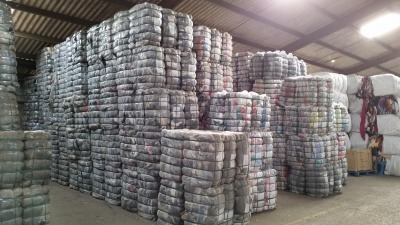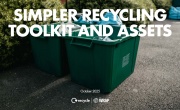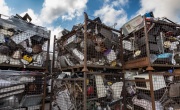UK is falling behind in its textiles strategy
The UK – once the global leader in driving progress towards a circular textiles industry – is lagging behind other countries in delivering key policy interventions. Alan Wheeler, CEO of the Textile Recycling Association, looks at some of the challenges facing the industry.
 The case for delivering a circular economy for textiles is stark and imperative. Estimates suggest that the fashion industry is currently responsible for around eight to ten per cent of all global greenhouse gas emissions and – if left unchecked – could account for over 25 per cent by 2050.
The case for delivering a circular economy for textiles is stark and imperative. Estimates suggest that the fashion industry is currently responsible for around eight to ten per cent of all global greenhouse gas emissions and – if left unchecked – could account for over 25 per cent by 2050.
The disappearance of the Aral Sea in central Asia is also attributed by many to the over-irrigation of cotton farms. Despite this being one of the world’s biggest environmental disasters, it is largely unknown and unreported. At the same time, it is said in China that you can tell the colour of this season’s fashion just by looking at the colour of the rivers as effluent from the dye houses is released straight into the rivers.
Yet, because much of the environmental impact of fashion is realised at the production end, this means that reusing items and keeping clothing in use for as long as possible results in major environmental benefits.
Used textiles in the UK
A recent report by the European Recycling Industries Confederation (EuRIC) concluded that buying an item of used clothing is 70 times better for the environment than buying brand new and, once an item is worn out, recycling the fibres delivers significant environmental savings. So reuse followed by recycling has a fundamental role in delivering a circular economy for textiles and delivering these major environmental goals.
In terms of actual amounts of used textiles collected per person, the UK is just about the highest in the world. We have an extensive network of clothing/textile collection banks like many other Northern European countries, but we also have a unique benefit of an extensive network of over 10,000 charity shops. Charity shops and textile banks account for around 85 per cent of all the estimated 620,000 tonnes that are collected annually in the UK. But we cannot celebrate this because we are also one of the biggest consumers of fast fashion.
The Environmental Audit Committee has stated that we buy more new clothing per person in the UK than any other European country, and compared to some twice as much. We are still throwing away an estimated 336,000 tonnes of clothing in household bins annually and 921,000 of textiles in total. We might collect more than our European neighbours, but we are much bigger consumers of fast fashion, throwing much more away.
Furthermore, much of what we put in the bin is not necessarily bad quality, but just worn out. Systems need to be in place to effectively segregate the reuse and recycling grades. But where will these recycling grades go?
The status of textile recycling
At the moment, most textiles are mechanically recycled by pulling or cutting the items. They are manufactured into products such as insulation for heat, sound and impact, and wiping cloths or blankets which are made out of recycled shoddy (wool) yarn. However, because of the presence of dyes and finishes, and the shortening of fibre length during the pulling/cutting process, the possibility of recycling textile items back into similar items is severely limited.
To be recycled, the textiles have to be sorted by colour and fibre type and then blended with virgin fibres. With current techniques, only up to about 20 per cent of the total fibre content in a garment can come from recycled textiles before the performance of the item is affected. Some of this recycling takes place in the UK, but most has now off-shored to Pakistan, which has an established specialised mechanical recycling industry. India is also a significant market.
What is difficult to do at a commercial scale is to recycle textile items back into similar types of textile items. To do this we need to commercialise recycling techniques that can remove the dyes and finishes that are applied to the textiles, deal with the non-textile items such as buttons and zips, separate out the different blends (e.g. polyester from cotton in a polycotton blend) and maintain the fibre length.
There are a number of actors that are developing chemical recycling processes for textiles that could deliver this, but these are still largely in the lab or demonstration plant stage. Plus, with the values of recycling grades likely to remain low until a critical point in demand is met, it will make little economic sense for sorters to separate out low-value recycling grades to the required standard, even where it is technically feasible.
Currently, sorting is still largely done by hand by trained professionals. So we need to improve the economics of sorting for recycling as well, which is why a number of businesses are working on developing automated sorting techniques for recycling grades. Some use near infra-red technology to identify fibre types which then whisk the garment along a belt before being separated off into an appropriate compartment. Progress is being made in this area, but new garments are still not being designed for recycling and blended fibres and dark colours remain an issue. Other sorting technologies are being developed around tagging and scanning, but there is a legacy issue here and consumers often cut these types of things out.
The future for sustainable textiles
There is a lot of work to be done in this area and for many years our sector – with some encouragement from our government – has been taking the lead in these matters globally. Just recently, we welcomed the public announcement by UK Research and Innovation of a £4 million funded project to develop an automated sorting and recycling demonstrator plant for the UK, and the Textile Recycling Association (for whom I work) is proud to be part of this project. Furthermore, UKRI has allocated a further £11 million to be spent on other R&D projects in this area in the current spending round. We can expect to hear an announcement on the allocation of £6 million pounds of this later this year.
This research is of course very welcome, but on a policy level, our government’s recent lack of action is giving the whole clothing and textile supply chain cause for concern.
Textiles was identified as one of the five priority materials to be consulted upon for Extended Producer Responsibility and other sustainable business models in the Waste Strategy in 2018. In 2021, we were promised that this would be completed by 2022. To date, this has not happened.
In a recent letter to the Textile Recycling Association, Minister Rebecca Pow acknowledged the significant impact of textiles and said that the Government remained committed to making progress in this area but also cited that the government has also needed to recognise current departmental resources as well as risks of the cumulative burden on business. As a result of this, the Secretary of State confirmed to the Environmental Audit Committee that Defra is not exploring Extended Producer Responsibility for textiles in the near future as they are focusing their efforts on delivering EPR for packaging.
This is of course very disappointing. We do not want to take anything away from the important work that my colleagues and compatriots are doing to deliver packaging reforms and DRS. However, our government keeps saying that they are taking climate change and their net zero targets seriously, and – to do so – they need to allocate the necessary resources that will deliver a sustainable fashion and textiles industry.
Legislation to improve textile recycling
The Textile Recycling Association stand shoulder-to-shoulder with our supply chain partners in organisations such as Textiles 2030, UK Fashion and Textiles, the British Fashion Council and the Institute of Positive Fashion. We all want an effective mandatory EPR scheme on clothing and textiles and other relevant policy interventions. Without legislative backing, we will not achieve what needs to be achieved. The pioneers of a sustainable fashion industry will continue to do what they can but, without the law on our side, we will continue to have businesses that choose to do nothing and continue with their damaging business practices.
The rest of Europe is now overtaking us in terms of policy development. The Netherlands has just become the second country in the world to enact an EPR scheme for clothing. Additionally, the EU textiles strategy will be setting out a framework for such schemes covering all EU member states going forward and from 2025 it will be compulsory for all municipalities within the EU to have separate collections of textiles. We were promised when we left the EU that our environmental standards would match and be better than that of the EU. I want to see this happen.









